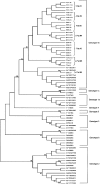Occult hepatitis C virus infection among hemodialysis patients
- PMID: 18684893
- PMCID: PMC2588096
- DOI: 10.1681/ASN.2008030293
Occult hepatitis C virus infection among hemodialysis patients
Abstract
Occult hepatitis C virus (HCV) infection (i.e., detectable HCV-RNA in the liver or peripheral blood mononuclear cells) in the absence of both serum HCV-RNA and anti-HCV antibodies has not been investigated in hemodialysis patients. In this study, real-time PCR and in situ hybridization was used to test for the presence of genomic and antigenomic HCV-RNA in peripheral blood mononuclear cells of 109 hemodialysis patients with abnormal levels of liver enzymes. Occult HCV infection, determined by the presence of genomic HCV-RNA, was found in 45% of the patients; 53% of these patients had ongoing HCV replication, indicated by the presence of antigenomic HCV-RNA. Patients with occult HCV infection had spent a significantly longer time on hemodialysis and had significantly higher mean alanine aminotransferase levels during the 6 mo before study entry. Logistic regression analysis revealed that mortality was associated with age >60 yr (odds ratio 3.30; 95% confidence interval 1.05 to 10.33) and the presence of occult HCV infection (odds ratio 3.84; 95% confidence interval 1.29 to 11.43). In conclusion, the prevalence of occult HCV infection is high among hemodialysis patients with persistently abnormal values of liver enzymes of unknown cause. The clinical significance of occult HCV infection in these patients requires further study.
Figures
Comment in
-
Occult hepatitis C virus infection in hemodialysis.J Am Soc Nephrol. 2008 Dec;19(12):2248-50. doi: 10.1681/ASN.2008101051. Epub 2008 Nov 19. J Am Soc Nephrol. 2008. PMID: 19020002 No abstract available.
References
-
- Clarke B: Molecular virology of hepatitis C virus. J Gen Virol 78: 2397–2410, 1997 - PubMed
-
- Fabrizi F, Lunghi G, Ganeshan SV, Martin P, Messa P: Hepatitis C virus infection and the dialysis patient. Semin Dial 20: 416–422, 2007 - PubMed
-
- Barril G, Traver JA: Decrease in the hepatitis C virus (HCV) prevalence in hemodialysis patients in Spain: Effect of time, initiating HCV prevalence studies and adoption of isolation measures. Antiviral Res 60: 129–134, 2003 - PubMed
-
- Recommendations for preventing transmission of infections among chronic hemodialysis patients. MMWR Recomm Rep 50: 1–43, 2001 - PubMed
Publication types
MeSH terms
Substances
LinkOut - more resources
Full Text Sources
Medical


